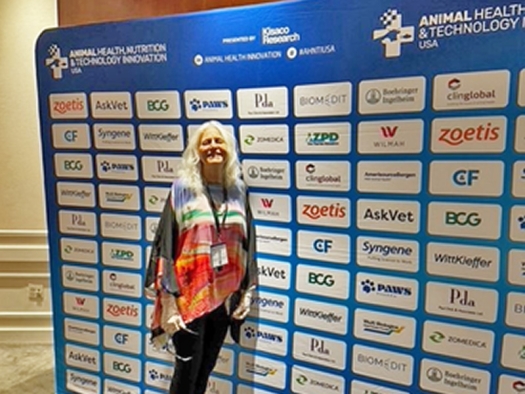MargoRomanAnimalHealthConference2024.jpg

Photo courtesy of Margo Roman.
Margo Roman at the 2024 Animal Health, Nutrition, and Technology Innovation Conference in Boston.
I recently had the opportunity to attend the Animal Health, Nutrition, and Technology Innovation conference in Boston, held on June 12-13, 2024. This gathering brought together innovative companies, veterinarians, and investors, all eager to explore the latest advancements in veterinary technology. Two years ago, I was a speaker at this conference, presenting on the microbiome. This year, I attended as a participant and was thrilled to see the increased focus on microbiome research. Additionally, the concept of artificial intelligence (AI) in veterinary medicine, now often referred to as “adjunctive intelligence,” was making significant waves.
One of the major takeaways from my discussions with various AI platform representatives was the importance of inclusive and accessible data. I emphasized the need for these platforms to incorporate integrative medical options when providing care choices for doctors and pet owners. For instance, when diagnosing an animal with a foot infection, it's crucial to include alternative treatments such as medical ozone, green tea soaks, wound drainage, laser therapy, and ultraviolet blood therapy, alongside traditional antibiotics. Over-reliance on antibiotics contributes to global antibiotic resistance, a pressing issue with over 1.3 million human deaths annually. The choices we make in veterinary care can have far-reaching impacts on this statistic.
During the conference, I also had the chance to share information about our fecal bank with many individuals and companies. Our goal is to highlight the potential of rebooting the immune system and gut health using the most pristine and protected microbiome. Over the past 30 years, we have safeguarded our donor dogs’ microbiomes, ensuring they remain in top condition to aid in restoring and preventing damage in other dogs. Companies like Legacybiome and Animalbiome, which utilize our microbiomes, benefit from this meticulous care.
Legacybiome employs microbiome mixology with our donor dog family, while Animalbiome offers our microbiome under the "Naturally Reared Dogs" label.
A highlight of the conference was a roundtable discussion on chronic diseases. The moderator posed a thought-provoking question: "What chronic disease do you feel progressive research and development could make an impact on, and how should new medications be delivered to ensure compliance with pet owners?" The diseases discussed included chronic kidney disease (CKD), irritable bowel disease (IBD), spinal demyelination, and cognitive decline.
Despite my 47 years of veterinary experience and a strong background in integrative medicine, I found there was limited knowledge of holistic approaches to these issues among the attendees. I felt compelled to share the possibilities of allowing the body to heal itself through microbiome restoration and the use of medical ozone, acupuncture, laser therapy, ultraviolet blood light, and other holistic therapies. I shared cases from my practice to illustrate the potential of these treatments:
- Blossom, a 17-year-old cat with kidney failure: After being advised to prepare for euthanasia by her regular vet, Blossom’s owners brought her to me. With a regimen of acupuncture, herbs, homeopathy, dietary changes, and subcutaneous ozonated saline, Blossom thrived for another seven years, ultimately living to the age of 24.
- Doug, an 18-month-old red standard poodle with chronic diarrhea: After unsuccessful treatments by multiple veterinarians, Doug came to me. Suspecting atypical Addison’s disease and Plechner syndrome, I administered ozone, UVBI, and fecal transplants, alongside nutritional support. Doug’s diarrhea resolved within two days, marking his first normal stools since his owner acquired him.
- Josie, a dog with cancer and cognitive decline: Through microbiome transplants and holistic support, Josie experienced improved gut absorption, increased nutrient intake, and an overall boost in vitality. This allowed her to enjoy activities like running in the yard and playing with a stick, bringing joy to her and her owner despite her illness.
- King, a German Shepherd with canine demyelination of the spinal cord: This condition, often seen in older German Shepherds but also in other breeds, responds well to flooding the spinal area with ozonated saline, combined with acupuncture, aquapuncture, or electroacupuncture. Nutraceuticals supporting the spine, musculature, and neuronal tissue have shown positive results. Administering microbiome restorative therapy (MBRT) with young, vital microbes can significantly enhance the dog’s quality of life. This approach helps improve neural activity and the precursors of neurotransmitters necessary for spinal health.
These cases underscore the potential of holistic and integrative approaches in veterinary medicine. By supporting the immune system and overall health through microbiome restoration and other therapies, we can offer our animal companions a better quality of life and, in many cases, extend their time with us.
As I shared these stories, I hoped to inspire my colleagues to consider these alternative methods and recognize the importance of nurturing the gut-brain, gut-liver, gut-kidney, and gut-musculoskeletal connections. My passion and enthusiasm for these treatments stem from a desire to see more animals benefit from holistic care and to contribute to a more sustainable approach to veterinary medicine.
In conclusion, the Animal Health, Nutrition, and Technology Innovation conference was a valuable experience that reinforced my commitment to advancing integrative veterinary care. By continuing to explore and share these innovative treatments, we can help more animals lead healthier, happier lives.


